North Malabar
North Malabar | ||
|---|---|---|
Geographical / Historical Area | ||
|
Clockwise from top: Vidhan Sabha constituency 24 | | |
| Civic agency | Northern Range, Kerala Mahé Sub-Division, Puducherry | |
North Malabar refers to the geographic area of southwest
The North Malabar region is bounded by
North Malabar begins at
Etymology
Until the arrival of
History
Ezhimala kingdom
The ancient port of Naura, which is mentioned in the Periplus of the Erythraean Sea as a port somewhere north of Muziris is identified with Kannur.[19]
The Ezhimala dynasty had jurisdiction over two Nadus - The coastal Poozhinadu and the hilly eastern Karkanadu. According to the works of
North Malabar was a hub of
Mushika dynasty
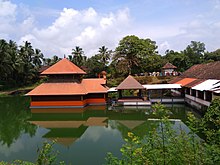
Between the 9th and 12th centuries, a dynasty called "Mushaka" controlled the Chirakkal areas of northern Malabar (the Wynad-Tellichery area was part of the Second Chera Kingdom). The Mushakas were probably the descendants of the ancient royal family of Nannan of Ezhi mala and were perhaps a vassal of the Cheras. The Kolla-desam (or the Mushika-rajya) came under the influence of the Chera/Perumals kingdom during eleventh century AD.[36] The Chola references to several kings in medieval Kerala confirms that the power of the Chera/Perumal was restricted to the country around capital Kodungallur. The Perumal kingship remained nominal compared with the power that local rulers (such as that of the Mushika in the north and Venatu in the south) exercised politically and militarily.[37] Medieval Kolla-desam stretched on the banks of Kavvai, Koppam and Valappattanam rivers. An
- Validhara Vikkirama Rama (c. 929 AD) - mentioned in the Ezhimala-Narayankannur inscription.[40]
- Kantan Karivarman alias Iramakuta Muvar (c. 1020 AD) [40] - mentioned in an Eramam inscription of Chera/Perumal Bhaskara Ravi Manukuladitya (962–1021 AD).[40]
- Mushikesvara Chemani/Jayamani (c. 1020 AD) - Tiruvadur inscription.[41]
- Ramakuta Muvar (as a donor to the Tiruvalla Copper Plates/Huzur Treasury Plates).[42]
- Utaiya-varma alias Ramakuta Muvar (early 12th century AD) - mentioned in the Kannapuram inscription.[38]
| Inscription | Location | Notes |
|---|---|---|
| Ramanthali/Ezhimala-Narayankannur inscription (929 AD) |
|
|
| Panthalayani Kollam inscription (973 AD) |
|
|
| Koyilandy Jumu'ah Mosque inscription (10th century AD) |
|
|
| Eramam inscription (1020 AD) | ||
| Pullur Kodavalam inscription (1020 AD) | ||
| Tiruvadur inscription (c. 1020 AD) |
| |
| Trichambaram inscription
(c. 1040 AD) |
|
|
Maniyur inscription
(c. 11th century) |
|
|
| Kinalur inscription
(c. 1083 CE) |
| |
| Panthalayani Kollam inscription
(c. 1089 AD) |
| |
Tiruvalla Copper Plates
(Huzur Treasury Plates)
(10th-11th centuries AD)
|
| |
| Kannapuram inscription
(beginning of the 12th century) |
|
|
Kolathunadu

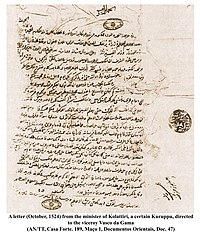
Until the 16th century CE, Kasargod town was known by the name Kanhirakode (may be by the meaning, 'The land of Kanhira Trees') in
The
During the 17th century, Kannur was the capital city of the only
Colonial era

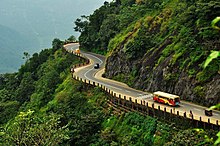

In 1761, the British captured Mahé, and the settlement was handed over to the ruler of Kadathanadu.[63] The British restored Mahé to the French as a part of the 1763 Treaty of Paris.[63] In 1779, the Anglo-French war broke out, resulting in the French loss of Mahé.[63] In 1783, the British agreed to restore to the French their settlements in India, and Mahé was handed over to the French in 1785.[63]
The northern parts of
The East India Company
, making them the first modern municipalities in the modern state of Kerala.Initially the British had to suffer local resistance against their rule under the leadership of
Culture and people
The socio-cultural background and geography of this area has some distinctions compared to the rest of Kerala.



Kottiyoor Utsavam
Kottiyoor Vysakha Mahotsavam is a 27-day yearly pilgrimage commemorating the mythology of Daksha Yaga, which attracts thousands of
Social, cultural and historical features


In the pre-democratic era,
Landlords in Malabar during colonial and pre-colonial times were the largest landlords of Kerala and during this time political authority remained decentralized in contrast to that of the southern principalities. The royal position of Kolathiri, although immensely respected, was politically titular. In North Malabar, the Kolathiri Kings had the ritualistic status of Perumaal such that their official designates or sthanis retained their jurisdiction all over Kerala except for the Rajarajashwara Temple at Taliparamba.
The major festival observed by Hindus in this region is
People from all religions participate in major festivals at temples, mosques and churches. Some examples include: Nadapuram Mosque, Mahe Church, Moonnu Pettumma Palli Pappinisseri and Theyyam ritual art.
Unlike
North Malabar cuisine is noted for its variety of dishes including chutneys, pancakes, steamed cakes and various dishes such as
People from this area are characterized by a stronger sense of socio-political aspirations often leading to large outbreaks of political violence.[citation needed]
Textiles, beedi, hand-weaving, plywood and coir represent important industries while cashew, cinnamon (North Malabar is home to Asia's largest cinnamon farm) and pepper are important cash crops.
North Malabar represents one of the earliest and largest pockets of exposure to other cultures in Kerala through

Main Cities/Towns


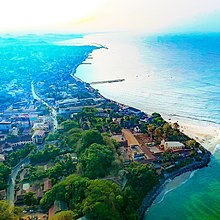















Calendar system
The version of the
Dialects
There are several dialects of the
| Some influences are enumerated | |
| Loaned from | Usages |
|---|---|
| Hebrew | Shalom/salaam aayi meaning died (lit. entered the state of peace). |
| Arabic | Bejaar meaning anxiety; matlab meaning consequence; barkat/varkkat meaning value are few examples |
| Portuguese | Veeppa meaning "basket“; 'maesha' meaning "table“; 'jenela' meaning "window“ |
| Cryptic Sanskrit tendencies | In North Malabar fish curry is referred to as malsya-curry (from the Sanskrit word matsya for fish) rather than southern usage of meen-curry. Similarly, feeling hungry is paikkunnu rather than southern usage of vishakkunnu. Other examples are annam instead of choru (cooked rice), dhani instead of kaashukaaran (rich man), the word amba (mother) for cow, gauli (lizard) etc. |
-
Malik Deenar Mosque
-
The intricate work on a North Malabar Hookah
-
Pazhassi Kudeeram inMananthavadi


Historic immigrations into North Malabar
Tulu Brahmin immigration
In 1617, the
Nasrani Migration
The Malabar Migration refers to the large-scale migration of Syrian Christians (Nasranis) from the Travancore region to the Malabar area of northern Kerala in the 20th century. The migration started in the decades of the 20th century and continued well into the 1970s and 1980s. This migration had a significant demographic and social impact as the Syrian Christian population of Malabar increased 15-fold from 31,191 in 1931 to 442,510 in 1971.
Central Travancore had experienced a steep increase in population in the early 20th century while pressure on arable land increased. At the same time, people recognised the potential of the large uncultivated lands in the northern regions called Malabar, which was then part of the Madras Presidency under British Rule. Migration initially started in trickles with land bought from the local rulers. Huge tracts of uncultivated forest and waste land were later converted into farms and plantations. Against the odds, the community thrived, which attracted more migrants. This migration reached its peak in the 1950s.[citation needed]
These migrants came mostly from present day
- Kasaragod -Malom, Kallar, Chittarikkal, Vellarikundu, Panathady, Panathur
- Kannur - Chempanthotty
- Calicut - Thiruvambady, Kuttiady
- Malapuram - Nilambur, Edakkara, Chungathara
- Wayanad - Pulpally
The Syro-Malabar Catholic Church gave significant support to the migration by providing churches, discipline, schools, hospitals and other infrastructure.
Overall, hundreds of thousands of people moved to North Kerala. The percentage of Christian residents in these districts was small before the migration but since 1950 this settler community has formed a significant part of the population in the hill areas of these districts.
Immigration of Knanaya Christians

Historically, the North Malabar landlords were the largest land-holders in Kerala, but the introduction of the Kerala Land Reforms Bill in 1957 resulted in their panic selling of farm and forest land. This was followed by immigration of Christians from

In addition, taking advantage of the selling spree of landlords of Malabar in general and more particularly the larger landlords of North Malabar, several other Travancore Christian families immigrated into Malabar to pursue agriculture. These migrations peaked during 1960–71.
Immigration of teachers
The number of large land owning private-Tharavad-owned schools in North Malabar expanded in the first half of the twentieth century partly due to the availability of government grant-in-aid for such enterprises from 1939 onwards. Furthermore, corporate expansion of land owning Tharavads and a decrease in European engineered proletysing of the depressed classes also contributed to the growth pattern. These schools often had teaching staff from educated families.[86] In democratic Kerala however, many of these schools evolved as public and government enterprises, which led to the recruitment of teachers from the southern provinces and the subsequent immigration of teaching staff of all ethno-religious backgrounds, many of whom preferred to settle in the area permanently.
Historic emigrations to Southern Kerala
Historically significant emigration from North Malabar occurred in three phases.

Dispersement of the erstwhile ruling elite
From 1766 to 1792, during the era of
- Neerazhi Kovilakam
- Gramathil Kottaram
- Paliyakkara
- Nedumparampu
- Chempra Madham
- Ananthapuram Kottaram
- Ezhimatoor Palace
- Aranmula Kottaram
- Varanathu Kovilakam
- Mavelikkara
- Ennakkadu
- Murikkoyikkal Palace
- Mariappilly
- Koratti Swaroopam
- Kaippuzha Kovilakam
- Lakshmipuram Palace
- Kottapuram.

Adoptions by the erstwhile ruling elite
The
.Economic migration in democratic India
In 1956, the State of Kerala was formed along linguistic lines, merging the Travancore, Cochin and Malabar regions. The first Kerala Legislative Assembly was formed on 1 March 1957 and the following 50 years saw migration of lawyers, politicians, businessmen and government officials from North Malabar to the southern cities of Kerala especially
Folk art
North Malabar has a rich history of folk-art, culture and tradition. The government of Kerala has encouraged promotion of these through the Kerala Folklore Academy at Kannur. Among the notable examples are:
Theyyam
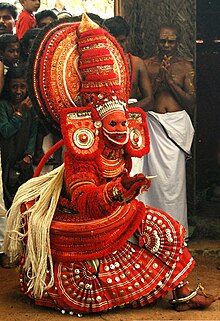
Theyyam, an ancient ritual performance art of the region in which a man is dressed symbolically as god. In the Kadathanadan area, it is known as kaliyattam. There are around 400 types of Theyyam, which are conducted on a stage and use elaborate costumes and body-painting. Each type has a distinguishing head-dress and costume made from natural materials, such as coconut leaves and bark. Musical accompaniments are provided by the chenda, elathalam and kuzhal (horn).
Thottam Pattu
Thottam Pattu is ballad sung just before performance of the Theyyam ritual.
Kalaripayattu
Vadakkan Pattukal
The Vadakkan Pattukal are ballads that extol the adventures of the brave men and women of North Malabar. Set against a feudal medieval background, the stories celebrate the valour and skills of their characters. The ballads reflect the peak of Kerala folk-poetry and are associated with Kadathanadu. The movie Oru Vadakkan Veeragatha capitalised on the popularity of these stories.
Thidambu Nritham
Thidambu Nritham (dance with the replica of the deity) is a ritual dance performed in temples. It is mainly performed by Nambudiri Brahmins and occasionally by other Brahmin communities.
Poorakkali
Kolkali
Kolkali is an art form involving both men and women which is also seen in South Malabar too. It is the only folk art that is performed by both Hindus and Muslims, although there are slight differences in how the two do it. Muslims perform it as a form of entertainment during social gatherings and marriages, whereas the Hindus perform it at temple festivals. It involves rapid limb movements and simultaneous chanting of folksong, with the performers moving in pairs, hitting their batons (koles) against each other in a methodical way in tune with folksongs. It is played according to Vaithari or Thalam by the Gurukkal (Teacher).
The typical Kolkali group will contain between sixteen and twenty members. One among them will sing the folksong and it will be chorused by rest. Harmonizing with generational changes, Kolkali like all other folk-art of North Malabar, has also changed its look and style over time. The noted Kolkali groups are found in the
Mappila (Muslim) folklore
Mappila folklore has deep roots in the region. The major Mappila arts of Malabar region (both North and South Malabar) are :
- Oppana
- Duff Muttu
- Mappila Paattu
Eruthukali
Erutukali is a folk art popular in hilly areas of North Malabar region, which is performed by the Mavilan community on the tenth day of
Malabar Cuisine
The Malabar cuisine depicts it culture and heritage. Malabar cuisine is a blend of traditional
The
The snacks include

Notable individuals
- Kannur Districtof Kerala State. He waged war against Mysore and the British for 27 years.
- K. Kelappan - was the founder President of the Nair Service Society who later became the principal of a school run by the society. He fought for social reforms on the one hand and against the British on the other. He was a great revolutionary, social reformer and crusader for justice to the backward classes. He was called Kerala Gandhi.
- P. T. Usha- The first Indian sprinter to reach the Olympics. Winner of several gold medals in the Asian Games.
- Lt Gen UNPROFOR.
- E. K. Nayanar - (December 1918 - May 2004) born in Kalliasseri, Kannur was a prominent Indian political leader of the Communist Party of India (Marxist). He held the post of Chief Minister of Kerala three times. He was the longest-serving Chief Minister of Kerala, serving a total of 4009 days.
- K. Karunakaran - (July 1918 - December 2010) was an Indian politician from Chirakkal in the Kannur District. He held the post of Chief Minister of Kerala four times, making him the person who became the Chief Minister for the most number of times, and was also the second longest-serving Chief Minister of Kerala after Nayanar.
- Pinarayi Vijayan - veteran Communist leader, former State secretary of Communist Party of India (Marxist) and current Chief Minister of Kerala.
- Vijay K. Nambiar - Former ambassador to China and Pakistan and former Chef de Cabinet (Chief of Staff) under UN Secretary-General Ban Ki-moon.
- Gireesh Puthenchery- Well known lyricist and screenwriter in the Malayalam film industry.
- T. V. Chandran - Well known director in the Malayalam film industry.
- Vineeth - born on 23 August 1969, a South Indian film actor and classical dancer.
- M. N. Nambiar - (1919—2008) film actor in Tamil cinema who spent more than 50 years in the film industry.
- William Logan, researchers on the history, language, culture of Kerala.
- Kannavath Sankaran Nambiar - Minister of Pazhassi Raja who was active in resistance to Mysorean and British invaders.
- Sreenivasan - Noted Malayalam actor and director.
- Samvrutha Sunil - Noted Malayalam film heroine.
- Kavya Madhavan - Popular Malayalam film actress.
- O. M. Nambiar - Renowned as an Indian athletics coach.
- Gandhian, educational and social activist.
- V.S. Achuthanandanministry from 2006 to 2011, and former State secretary of Communist Party of India (Marxist).
- Kanayi Kunhiraman - Sculptor.
- M. Mukundan - Novelist and diplomat.
- K. Raghavan - Veteran Malayalam music director.
- Abu Salim (actor) - Popular film actor and Mr India Title winner in 1984 and 1992.
- C. P. Krishnan Nair - Internationally known businessman from the Leela Group of Hotels.
- Sanusha - Noted film actress.
- Anaswara Rajan - Noted film actress.
- Maliyekkal Mariyumma - Social reformer
See also
References
- ^ Census of India, 2001. Census Data Online, Population.
- ^ ISBN 9788120604476.
- ^ M. Vijayanunni. 1981 Census Handbook- Kasaragod District (PDF). Directorate of Census Operations, Kerala.
- ^ ISBN 9788126415786.
- ^ Government of Madras (1953). 1951 Census Handbook- Malabar District (PDF). Madras Government Press.
- ^ Pamela Nightingale, ‘Jonathan Duncan (bap. 1756, d. 1811)’, Oxford Dictionary of National Biography, Oxford University Press, 2004; online edn, May 2009
- ^ "Navy-Training Academy-proposed Expansion". Deccan Herald. 11 August 2017.
- ^ "Asia's largest naval academy opened". Arab News. 10 January 2009.
- user-generated source]
- ^ Gibson, David K. "The best beaches for driving". Retrieved 26 June 2016.
- ^ "Muzhappilangad wins BBC favour". deccanchronicle.com. 24 June 2016.
- ^ ISBN 9788126415885. Retrieved 19 July 2020.
- ^ J. Sturrock (1894). "Madras District Manuals - South Canara (Volume-I)". Madras Government Press.
- ^ V. Nagam Aiya (1906). The Travancore State Manual. Travancore Government Press.
- ^ C. A. Innes and F. B. Evans, Malabar and Anjengo, volume 1, Madras District Gazetteers (Madras: Government Press, 1915), p. 2.
- ^ M. T. Narayanan, Agrarian Relations in Late Medieval Malabar (New Delhi: Northern Book Centre, 2003), xvi–xvii.
- ^ Mohammad, K.M. "Arab relations with Malabar Coast from 9th to 16th centuries" Proceedings of the Indian History Congress. Vol. 60 (1999), pp. 226–34.
- ISBN 978-81-206-0446-9.
- ISBN 9788126415786.
- ^ Gurukkal, R., & Whittaker, D. (2001). In search of Muziris. Journal of Roman Archaeology, 14, 334-350.
- ^ A. Shreedhara Menon, A Survey of Kerala History
- ^ According to Pliny the Elder, goods from India were sold in the Empire at 100 times their original purchase price. See [1]
- ^ Bostock, John (1855). "26 (Voyages to India)". Pliny the Elder, The Natural History. London: Taylor and Francis.
- ^ Indicopleustes, Cosmas (1897). Christian Topography. 11. United Kingdom: The Tertullian Project. pp. 358–373.
- ^ Das, Santosh Kumar (2006). The Economic History of Ancient India. Genesis Publishing Pvt Ltd. p. 301.
- ^ District Census Handbook, Kasaragod (2011) (PDF). Thiruvananthapuram: Directorate of Census Operation, Kerala. p. 9.
- ^ a b Government of India (2014–15). District Census Handbook – Wayanad (Part-B) 2011 (PDF). Directorate of Census Operations, Kerala.
- ^ ISBN 978-8126415885. Retrieved 19 July 2020.
- ISBN 9780765601049.
- ISBN 978-0-231-70024-5. Retrieved 24 July 2012.
- ISBN 978-90-04-07929-8. Retrieved 25 July 2012.
- ISBN 978-81-903887-8-8. Retrieved 25 July 2012.
- ^ Prange, Sebastian R. Monsoon Islam: Trade and Faith on the Medieval Malabar Coast. Cambridge University Press, 2018. 98.
- ^ Pg 58, Cultural heritage of Kerala: an introduction, A. Sreedhara Menon, East-West Publications, 1978
- ^ a b c d e Aiyer, K. V. Subrahmanya (ed.), South Indian Inscriptions. VIII, no. 162, Madras: Govt of India, Central Publication Branch, Calcutta, 1932. p. 69.
- ^ Ganesh, K. N. (2009). Historical Geography of Natu in South India with Special Reference to Kerala. Indian Historical Review, 36(1), 3–21.
- ^ Noburu Karashmia (ed.), A Concise History of South India: Issues and Interpretations. New Delhi: Oxford University Press, 144-145
- ^ a b c d e Narayanan, M. G. S. Perumāḷs of Kerala. Thrissur (Kerala): CosmoBooks, 2013. 483.
- ^ Charles Alexander Innes (1908). Madras District Gazetteers Malabar (Volume-I). Madras Government Press. pp. 423–424.
- ^ a b c Narayanan, M. G. S. Perumāḷs of Kerala. Thrissur (Kerala): CosmoBooks, 2013. 180-181.
- ^ a b c d e Narayanan, M. G. S. Perumāḷs of Kerala. Thrissur (Kerala): CosmoBooks, 2013. 480-81.
- ^ a b Narayanan, M. G. S. Perumāḷs of Kerala. Thrissur (Kerala): CosmoBooks, 2013. 197.
- ^ a b c d e Narayanan, M. G. S. Perumāḷs of Kerala. Thrissur (Kerala): CosmoBooks, 2013. 475-76.
- ^ a b Narayanan, M. G. S. Perumāḷs of Kerala. Thrissur (Kerala): CosmoBooks, 2013. 448-49.
- ^ a b c d e Narayanan, M. G. S. Perumāḷs of Kerala. Thrissur (Kerala): CosmoBooks, 2013. 455.
- ^ Annual Reports of Indian Epigraphy (1963-64), No. 125.
- ^ a b Narayanan, M. G. S. Perumāḷs of Kerala. Thrissur (Kerala): CosmoBooks, 2013. 68-70, 84 and 454.
- ^ a b c Narayanan, M.G.S. THE IDENTITY AND DATE OF KING MANUKULĀDITYA. Proceedings of the Indian History Congress, Vol. 31, 1969, 73–78.
- ^ a b Narayanan, M. G. S. Perumāḷs of Kerala. Thrissur (Kerala): CosmoBooks, 2013. 465.
- ^ a b Narayanan, M. G. S. Perumāḷs of Kerala. Thrissur (Kerala): CosmoBooks, 2013. 486.
- ^ a b c d e f Narayanan, M. G. S. 2013. 'Index to Chera Inscriptions', in Perumāḷs of Kerala, M. G. S Narayanan, pp. 484–85. Thrissur (Kerala): CosmoBooks.
- ^ a b c d Narayanan, M. G. S. Perumāḷs of Kerala. Thrissur (Kerala): CosmoBooks, 2013. 470.
- ^ Keralolpatti Granthavari: The Kolattunad Traditions (Malayalam) (Kozhikode: Calicut University, 1984) M. R. Raghava Varier (ed.)
- ISBN 9788126437825.
- ^ Perumal of Kerala by M. G. S. Narayanan (Kozhikode: Private Circulation, 1996)
- ^ Ayinapalli, Aiyappan (1982). The Personality of Kerala. Department of Publications, University of Kerala. p. 162. Retrieved 27 July 2018.
A very powerful and warlike section of the Bants of Tulunad was known as Kola bari. It is reasonable to suggest that the Kola dynasty was part of the Kola lineages of Tulunad.
- ^ S. Muhammad Hussain Nainar (1942). Tuhfat-al-Mujahidin: An Historical Work in The Arabic Language. University of Madras.
- ^ M. Vijayanunni. 1981 Census Handbook- Kasaragod District (PDF). Directorate of Census Operations, Kerala.
- ^ The Hindu staff reporter (21 November 2011). "Neeleswaram fete to showcase its heritage". The Hindu. Retrieved 24 November 2016.
- ^ DC Books, Kottayam (2007), A. Sreedhara Menon, A Survey of Kerala History
- ^ Arakkal royal family Archived 5 June 2012 at the Wayback Machine
- ^ Charles Alexander Innes (1908). Madras District Gazetteers Malabar (Volume-I). Madras Government Press. p. 451.
- ^ a b c d "History of Mahé". Archived from the original on 30 December 2013. Retrieved 19 April 2021.
- ^ M. Vijayanunni (1983). 1981 Census Handbook- Wayanad District (Part-A&B) (PDF). Directorate of Census Operations, Kerala.
- ^ "CHRONOLOGICAL LIST OF CENTRAL ACTS (Updated up to 17-10-2014)". Lawmin.nic.in. Retrieved 7 August 2016.
- ^ Lewis McIver, G. Stokes (1883). Imperial Census of 1881 Operations and Results in the Presidency of Madras ((Vol II) ed.). Madras: E.Keys at the Government Press. p. 444. Retrieved 5 December 2020.
- ^ Presidency, Madras (India (1915). Madras District Gazetteers, Statistical Appendix For Malabar District (Vol.2 ed.). Madras: The Superintendent, Government Press. p. 20. Retrieved 2 December 2020.
- ^ HENRY FROWDE, M.A., Imperial Gazetteer of India (1908–1909). Imperial Gazetteer of India (New ed.). Oxford: Clarendon Press. Retrieved 2 December 2020.
- ^ Eleanor Kathleen Gough (1900), Nayar: North Kerala, University of California Press, (Berkeley, Los Angeles)
- ^ Eric J. Miller (1954), Caste and Territory in Malabar, American Anthropological Association
- ^ Praveena Kodoth (1998), Women and Property Rights: A Study of Land Relations and Personal Law in Malabar, 1880–1940' Unpublished PhD Dissertation, Department of Economics, University of Hyderabad
- ^ Ravindran Gopinath, 'Garden and Paddy Fields: Historical Implications of Agricultural Production Regimes in Colonial Malabar' in Mushirul Hasan and Narayani Gupta (eds.)
- ^ India's Colonial Encounters: Essays in Memory of Eric Stokes, Delhi: Monohar Publishers, 1993
- ^ M. Jayarajan, Sacred Groves of North Malabar, Discussion Paper No. 92 Archived 26 March 2009 at the Wayback Machine
- ^ Praveena Kodoth (2002), FRAMING CUSTOM, DIRECTING PRACTICES: AUTHORITY, PROPERTY AND MATRILINY UNDER COLONIAL LAW IN NINETEENTH CENTURY MALABAR [2]
- ^ Fawcett (1901), Nayars of Malabar, AES Reprint 1985
- ISBN 978-81-206-0170-3.
- ^ The Marumakkattayam And Aliyasantana System - Author - Manita Doshi
- ISBN 9788120601703.
- ^ Srishida's CookBook: -Malabar Sambar(Veg)
- ^ Malabar Sambar recipe – All recipes India
- Kollam era, Indian Journal of History of Science, 31 (1)"Archived copy" (PDF). Archived from the original (PDF) on 16 March 2012. Retrieved 31 March 2010.)
{{cite web}}: CS1 maint: archived copy as title (link - ^ Chakrakshaalanapuram Brahmaswam Sabhaayogam Manual
- ^ Fr. Jacob Vellian, Knanite Community, History and Culture
- ^ Kumbattu Varkey Joseph, Migration and economic development of Kerala
- ^ Kerala Development Report by Government of India Planning Commission
- William Logan(Printed and published by Charitram Publications under the editorship of Dr. C.K, Kareem, Trivandrum)
- ^ Voyage to East Indies by Fra Bartolomaeo (Portuguese Traveller and Historian)
- ^ Historical Sketches by Col. Wilks, Vol. II.
- ^ A Journey from Madras through the counties of Mysore, Canara and Malabar by Dr. Francis Buchanan Hamilton, Vol. II.
- ^ Mysore History by Lewis Rice.
- ^ Selected Letters of Tipu Sultan to various Functionaries by William Kirkpatrick, published in London, 1811.
- ^ History of Kerala by A. Sreedhara Menon.
- ^ History of Cochin State by K.P. Padmanabha Menon, Mathrubhumi Publication, 1989.
- ^ Cochin State Manual by C. Achuta Menon.
- Pillai.
- ^ Freedom Struggle in Kerala by Sardar K.M. Panicker.
- ^ Sakthan Thampuran by P. Raman Menon, Mathrubhoomi Publication, 1989.
- Pillai, N.B.S. Publications, Kottayam, 1973.
- Trichur and Carmichael Christian Mission, Varappuzha.
- ^ Bhasha Poshini of Chingam 10, 1099 (August 1923), Article on Tipu Sultan by Sardar K.M. Panicker.
- ^ Malabar Kalapam of 1921 by K. Madhavan Nair.
- ^ Travancore History by P. Sankrunni Menon.
- ^ Tipu Sultan X-rayed by Dr. I.M. Muthanna, Usha Press, Mysore 1980.
- Pillai.
- K.V. Krishna Iyer.
- ^ Tipu Sultan by B.N. Jog.
- ^ a b "ഗോത്ര സ്മൃതികളുണർത്തി എരുതുകളി." keralakaumudi.com (in Malayalam). Kerala Kaumudi. Retrieved 7 April 2023.
- ^ a b c d e f g Sabhnani, Dhara Vora (14 June 2019). "Straight from the Malabar Coast". The Hindu. Retrieved 26 January 2021.
- ^ "Thalassery Chicken Biriyani". The Take It Easy Chef. 23 June 2017. Retrieved 13 May 2021.
- ^ a b Kurian, Shijo (2 July 2014). "Flavours unlimited from the Malabar coast". The Hindu. Retrieved 26 January 2021.
- ^ "Arikkadukka - Spicy Stuffed Mussels". Faces Places and Plates. 30 June 2020. Retrieved 13 May 2021.
Further reading
General
- S. Muhammad Hussain Nainar (1942), Tuhfat-al-Mujahidin: An Historical Work in The Arabic Language, University of Madras (The English translation of Tuhfat Ul Mujahideen)
- William Logan (1887), Malabar Manual (Volume-I), Madras Government Press
- William Logan (1887), Malabar Manual (Volume-II), Madras Government Press
- Charles Alexander Innes (1908), Madras District Gazetteers Malabar (Volume-I), Madras Government Press
- Charles Alexander Innes (1915), Madras District Gazetteers Malabar (Volume-II), Madras Government Press
- Government of Madras (1953), 1951 Census Handbook- Malabar District (PDF), Madras Government Press
- J. I. Arputhanathan (1955), South Kanara, The Nilgiris, Malabar and Coimbatore Districts (Village-wise Mother-tongue Data for Bilingual or Multilingual Taluks) (PDF), Madras Government Press
- Rajabhushanam, D. S. (1963), Statistical Atlas of the Madras State (1951) (PDF), Madras (Chennai): Director of Statistics, Government of Madras
Kasaragod region
- J. Sturrock (1894), Madras District Manuals - South Canara (Volume-I), Madras Government Press
- Harold A. Stuart (1895), Madras District Manuals - South Canara (Volume-II), Madras Government Press
- Government of Madras (1905), Madras District Gazetteers: Statistical Appendix for South Canara District, Madras Government Press
- Government of Madras (1915), Madras District Gazetteers South Canara (Volume-II), Madras Government Press
- Government of Madras (1953), 1951 Census Handbook- South Canara District (PDF), Madras Government Press










